Presiding Deities of the Temple
LORD JAGANNATH (right), SUBHADRA (center), and BALABHADRA (left)
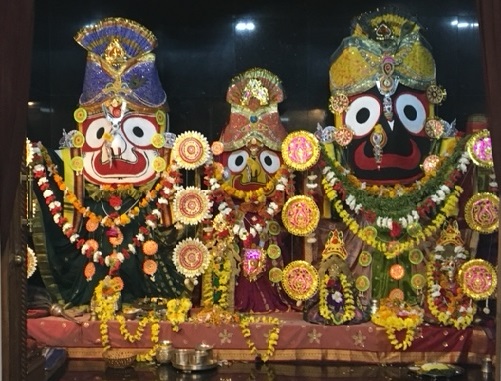 The word Jagannath literally means “Lord of the Universe”. He thus represents the Supreme Being. There are images of Jagannath, his brother Balabhadra and sister Subhadra. These images are made of wood. The original temple dedicated to Lord Jagannath is located in Puri, in the State of Orissa in India, overlooking the Bay of Bengal. The temple in Puri is a hoary pilgrimage center in India consisting of a vast complex occupying an area of over 40,000 square feet. The shikhara of the temple in Puri towers to a height of 192 feet. The temple in Puri took 14 years to build and was consecrated in 1198 CE. Lord Jagannath is believed to be Krishna, Balabhadra is Krishna’s brother Balarama, and Subhadra is Krishna’s sister. The most important festival for Jagannath is the spectacular Chariot festival or Ratha Yatra during the period of June-July every year.
The word Jagannath literally means “Lord of the Universe”. He thus represents the Supreme Being. There are images of Jagannath, his brother Balabhadra and sister Subhadra. These images are made of wood. The original temple dedicated to Lord Jagannath is located in Puri, in the State of Orissa in India, overlooking the Bay of Bengal. The temple in Puri is a hoary pilgrimage center in India consisting of a vast complex occupying an area of over 40,000 square feet. The shikhara of the temple in Puri towers to a height of 192 feet. The temple in Puri took 14 years to build and was consecrated in 1198 CE. Lord Jagannath is believed to be Krishna, Balabhadra is Krishna’s brother Balarama, and Subhadra is Krishna’s sister. The most important festival for Jagannath is the spectacular Chariot festival or Ratha Yatra during the period of June-July every year.
LORD VENKATESHWARA
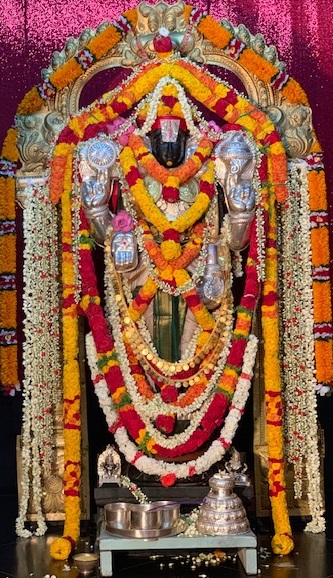 Lord Venkateswara is worshipped as Vishnu representing the Supreme functionality of sustaining, the presiding deity of the Tirumala Hills, in Andhra Pradesh, India. He is the one protecting and preserving the Universe. Lord Venkateswara, popularly known as Balaji, is the manifestations of Lord Vishnu, who has incarnated in the so-called cosmic time frame of kali-yuga corresponding to the present times we are living in. The sage requested Lord Vishnu to settle in Tirumala, to shower his eternal grace on mankind, who were very much depressed and unable to follow the rigorous yoga practices of self realization. Tirumala, the seat of Lord Venkateswara is surrounded by seven hills, thus He is known as Lord of the seven hills.
Lord Venkateswara is worshipped as Vishnu representing the Supreme functionality of sustaining, the presiding deity of the Tirumala Hills, in Andhra Pradesh, India. He is the one protecting and preserving the Universe. Lord Venkateswara, popularly known as Balaji, is the manifestations of Lord Vishnu, who has incarnated in the so-called cosmic time frame of kali-yuga corresponding to the present times we are living in. The sage requested Lord Vishnu to settle in Tirumala, to shower his eternal grace on mankind, who were very much depressed and unable to follow the rigorous yoga practices of self realization. Tirumala, the seat of Lord Venkateswara is surrounded by seven hills, thus He is known as Lord of the seven hills.
LORD SHIVA
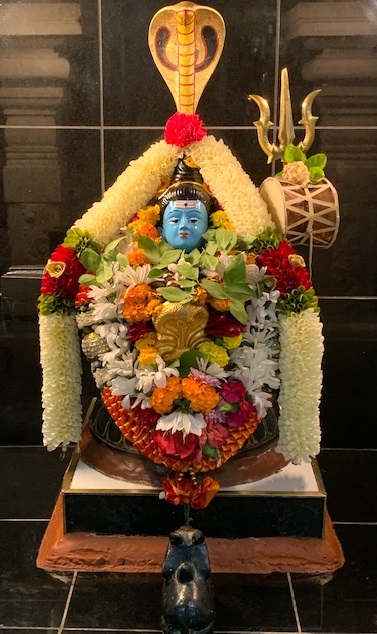
LORD GANAPATHI
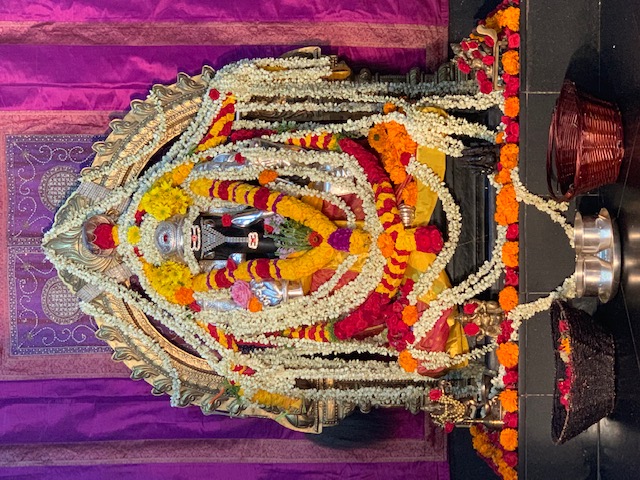 Lord Ganapathi (also known as Ganesha, Vinayaka, vigneshwara or Pillaiar) is worshipped as the remover of obstacles, and as the God of wisdom and success. He is described as the eldest son of Shiva and Parvathi, and is most well-known and found in almost all temples. There is a mythological story about how he got the elephant head. Please ask your guide to tell the story. The form of the elephant-headed deity is supposed to denote great physical strength tempered by gentleness, wisdom and peace. His vehicle is a mouse, which is supposed to represent the ego.
Lord Ganapathi (also known as Ganesha, Vinayaka, vigneshwara or Pillaiar) is worshipped as the remover of obstacles, and as the God of wisdom and success. He is described as the eldest son of Shiva and Parvathi, and is most well-known and found in almost all temples. There is a mythological story about how he got the elephant head. Please ask your guide to tell the story. The form of the elephant-headed deity is supposed to denote great physical strength tempered by gentleness, wisdom and peace. His vehicle is a mouse, which is supposed to represent the ego.
SRI DURGA
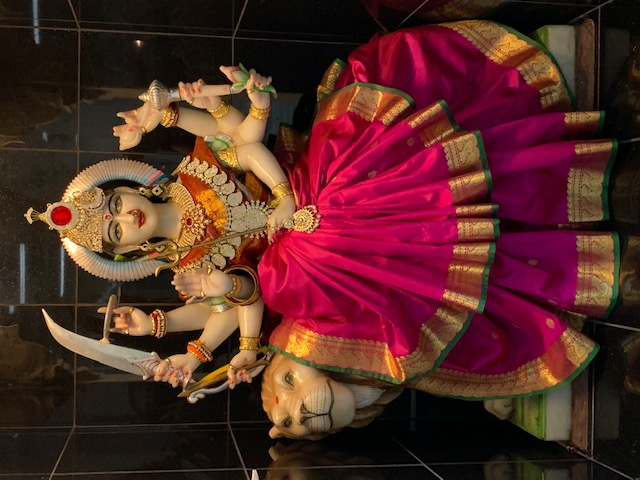 Sri Durga, as embodiment of Skathi (Strength and Power) is considered to be the supreme Goddess by the
Hindus and often referred to as Mother Durga. She is also the embodiment of courage, knowledge, purity, truth, beauty, grace, mercy, and self realization and is multi-dimensional with many names and
personas. As Mahishasurmardini, she, with her infinite might, slays the demon Mahishasura. As Parvati, (the Goddess of the mountain) she is serene and extremely
beautiful and adores Lord Shiva as his consort in the snowy peaks of Kailash mountain. As Kali, she turns into vibrant darkness, becomes omnipotent,
terrible in range and fury and destroys demons, evils and ego. As Ambika, she is the divine mother. As Durga, she protects the mankind from dangers and misfortunes,
sufferings and miseries.
Sri Durga, as embodiment of Skathi (Strength and Power) is considered to be the supreme Goddess by the
Hindus and often referred to as Mother Durga. She is also the embodiment of courage, knowledge, purity, truth, beauty, grace, mercy, and self realization and is multi-dimensional with many names and
personas. As Mahishasurmardini, she, with her infinite might, slays the demon Mahishasura. As Parvati, (the Goddess of the mountain) she is serene and extremely
beautiful and adores Lord Shiva as his consort in the snowy peaks of Kailash mountain. As Kali, she turns into vibrant darkness, becomes omnipotent,
terrible in range and fury and destroys demons, evils and ego. As Ambika, she is the divine mother. As Durga, she protects the mankind from dangers and misfortunes,
sufferings and miseries.
SRI MURUGA
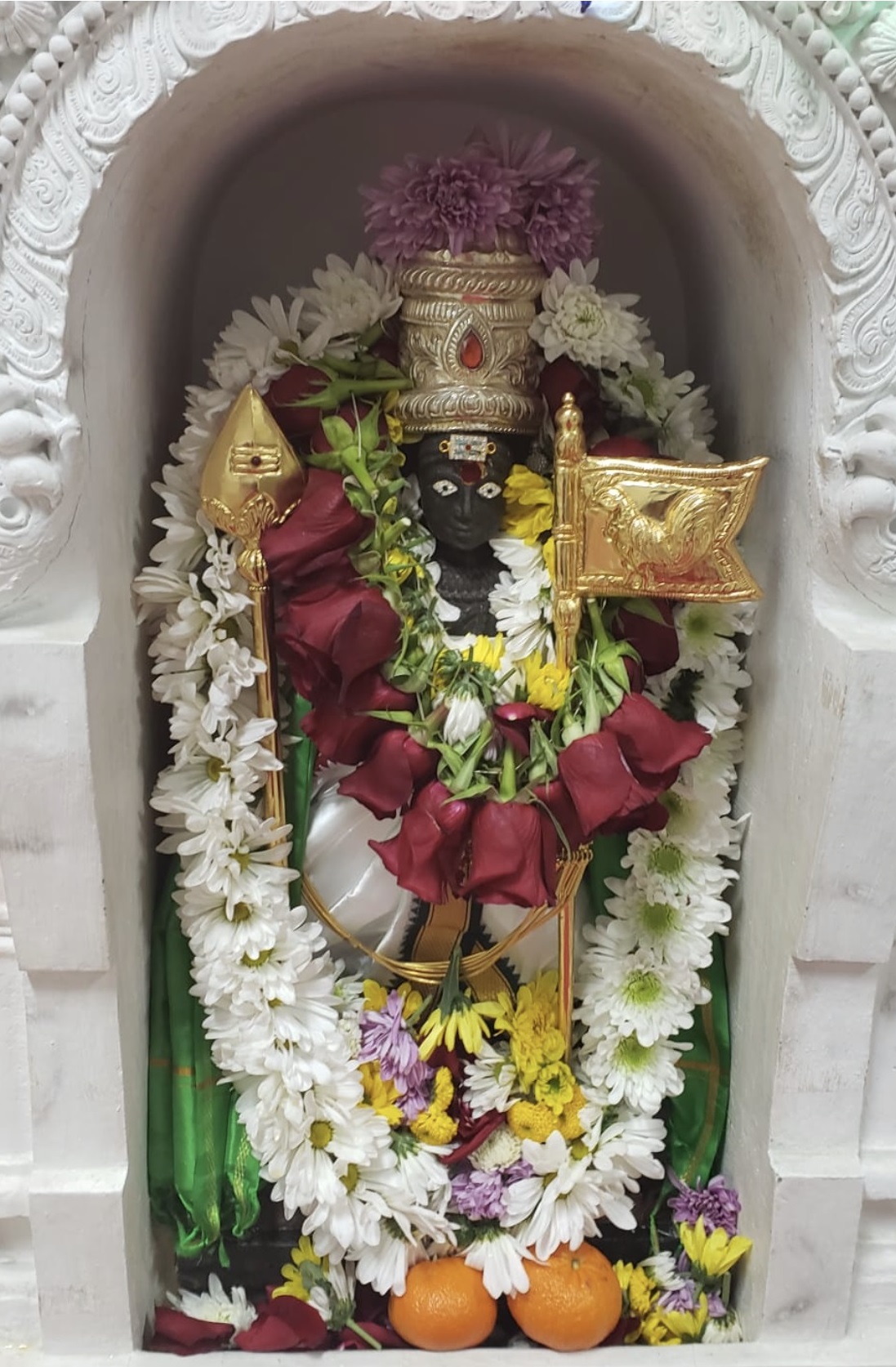 Sri Muruga, also known as Shanmuga, Subrahmanya, Kartikeya, Skandaa and Kumara, is the Hindu god of war. He is the son of Parvati and Shiva, brother of Ganesha, and a god whose life story has many versions in Hinduism.
An important deity found all over the Indian subcontinent in its history, Kartikeya is particularly popular in South India, such as among the Tamil people.
Sri Muruga, also known as Shanmuga, Subrahmanya, Kartikeya, Skandaa and Kumara, is the Hindu god of war. He is the son of Parvati and Shiva, brother of Ganesha, and a god whose life story has many versions in Hinduism.
An important deity found all over the Indian subcontinent in its history, Kartikeya is particularly popular in South India, such as among the Tamil people.
GODDESS KALI
 Goddess Kali, also called Mother Kali, is worshipped particularly in Bengal and Orissa. 'Kal' also means Time and 'i' means the Cause; Kali, the Cause of Time or She Who is Beyond Time, activates Consciousness to perception, and allows Consciousness to perceive. Kali is a powerful and complex goddess with multiple forms. The blackness of Kali is exhibitive of the endless beginning, the black sky of eternity, a dark deep from where creation began. Her long, dark hair in disarray is the black clouds of the eternal sky. The wreath of heads around her neck is a relic of death, destruction and calamity. The lower left arm holding a head just severed betokens no escape from time, while the upper left holds a sword, the arm of destruction. Lower right hand is posed as if giving a boon, and the upper right hand is posed granting freedom from fear. She wears two arrows as ornaments for her ears, and a girdle of the hands of her victims. Her features are gaunt, her three eyes are Sun, Moon and Fire, of which the third, represents foresight and wisdom, a harbinger of supreme knowledge that opens once the human sight is cleared of ignorance. Surrounded by powers of the night, she stands astride Mahadeva, lying beneath Her.
Goddess Kali, also called Mother Kali, is worshipped particularly in Bengal and Orissa. 'Kal' also means Time and 'i' means the Cause; Kali, the Cause of Time or She Who is Beyond Time, activates Consciousness to perception, and allows Consciousness to perceive. Kali is a powerful and complex goddess with multiple forms. The blackness of Kali is exhibitive of the endless beginning, the black sky of eternity, a dark deep from where creation began. Her long, dark hair in disarray is the black clouds of the eternal sky. The wreath of heads around her neck is a relic of death, destruction and calamity. The lower left arm holding a head just severed betokens no escape from time, while the upper left holds a sword, the arm of destruction. Lower right hand is posed as if giving a boon, and the upper right hand is posed granting freedom from fear. She wears two arrows as ornaments for her ears, and a girdle of the hands of her victims. Her features are gaunt, her three eyes are Sun, Moon and Fire, of which the third, represents foresight and wisdom, a harbinger of supreme knowledge that opens once the human sight is cleared of ignorance. Surrounded by powers of the night, she stands astride Mahadeva, lying beneath Her.
SRI MAHALAKSHMI
 Goddess Lakshmi is the goddess of wealth, light, wisdom, grace, charm, beauty and purity. She is the Mother of the Universe and Vishnu’s Shakti. She is married to Vishnu and appears as his mate in all of his reincarnations: as Sita (with Rama), as Rukmini (with Krishna) and as Padmavati with (Venkateshwara). She is also referred as Shri or Sri, as well as Narayani (“the wife of Narayan—Vishnu”). Goddess Lakshmi is identified with different forms of wealth. She is worshipped in nearly all households and businesses throughout the year. However, she is particularly worshipped during Dassera and Diwali.
Goddess Lakshmi is the goddess of wealth, light, wisdom, grace, charm, beauty and purity. She is the Mother of the Universe and Vishnu’s Shakti. She is married to Vishnu and appears as his mate in all of his reincarnations: as Sita (with Rama), as Rukmini (with Krishna) and as Padmavati with (Venkateshwara). She is also referred as Shri or Sri, as well as Narayani (“the wife of Narayan—Vishnu”). Goddess Lakshmi is identified with different forms of wealth. She is worshipped in nearly all households and businesses throughout the year. However, she is particularly worshipped during Dassera and Diwali.
Radha Krishna
 Radha and Krishna have been a perennial source of inspiration to Indians. Also, Lord Krishna is the most popular god in contemporary Hinduism. He is certainly the best known god outside India because of the Krishna Consciousness movement, and the Bhagvad Gita, one of the best spiritual guides to emerge from India. Krishna is the eighth avatar or reincarnation of the Lord Vishnu, born around 3102 BCE. He spent a happy childhood playing boyish pranks and attracting the gopis (cow girls) and other rustic maidens with his flute playing, which they found irresistible. But his favorite gopi was Radha, his childhood lover. Krishna has become the most popular focus of the devotional and ecstatic aspects of Hindu religion. Devotees of Krishna subscribe to the concept of lila, or divine play as the central principle of the universe.
Radha and Krishna have been a perennial source of inspiration to Indians. Also, Lord Krishna is the most popular god in contemporary Hinduism. He is certainly the best known god outside India because of the Krishna Consciousness movement, and the Bhagvad Gita, one of the best spiritual guides to emerge from India. Krishna is the eighth avatar or reincarnation of the Lord Vishnu, born around 3102 BCE. He spent a happy childhood playing boyish pranks and attracting the gopis (cow girls) and other rustic maidens with his flute playing, which they found irresistible. But his favorite gopi was Radha, his childhood lover. Krishna has become the most popular focus of the devotional and ecstatic aspects of Hindu religion. Devotees of Krishna subscribe to the concept of lila, or divine play as the central principle of the universe.
SITA RAM PARIVAR
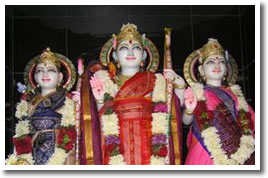 Rama, Sita, Lakshmana, and Hanuman together constitute the Sita Rama Parivar and each of them represents the noblest of various facets of human character one can aspire for. Lord Rama is the seventh avatar or reincarnation of Lord Vishnu. Lakshmana is his brother and Hunuman is his devotee. To a Hindu, Rama and Sita are the manifestation of a perfect man and a perfect woman. Their adherence to truth under numerous trials and temptations, their steadfast endurance under privations, and their devotion to duty under all vicissitudes of fortune, forms the Hindu ideal of a perfect human life. In this respect the Ramayana (life story of Rama) gives us a true picture of Hindu faith and righteous life. The applicability and relevance of Ramayana as a perennial source of human and moral values is confined not just to India, but to the entire universe.
Rama, Sita, Lakshmana, and Hanuman together constitute the Sita Rama Parivar and each of them represents the noblest of various facets of human character one can aspire for. Lord Rama is the seventh avatar or reincarnation of Lord Vishnu. Lakshmana is his brother and Hunuman is his devotee. To a Hindu, Rama and Sita are the manifestation of a perfect man and a perfect woman. Their adherence to truth under numerous trials and temptations, their steadfast endurance under privations, and their devotion to duty under all vicissitudes of fortune, forms the Hindu ideal of a perfect human life. In this respect the Ramayana (life story of Rama) gives us a true picture of Hindu faith and righteous life. The applicability and relevance of Ramayana as a perennial source of human and moral values is confined not just to India, but to the entire universe.
Navagrahas
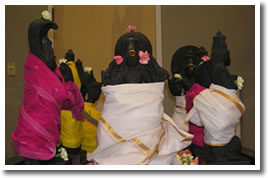 There are nine grahas (planets): Soorya (the Sun), Chandramaa (the Moon), Mangala (Mars), Budha (Mercury), Brihaspati (Jupiter), Shukra (Venus), Shani (Saturn) and Rahu and Ketu . Both Rahu and Ketu are fictitious grahas given by two nodes (in the sky), which when occupied by Chandramaa, cause the solar and lunar eclipses respectively. These nodes are the points of intersection of Chandramaa’s orbit around Prithvee (the Earth) with the ecliptic plane . Jyotisha (Vedic Astrology) ignores the three outermost planets: Uranus, Neptune and Pluto. Rahu and Ketu supposedly take into account the affects of the excluded planets. The planetary positions at the time of birth reveal the events of a person’s present life as well as their past and future lives.
There are nine grahas (planets): Soorya (the Sun), Chandramaa (the Moon), Mangala (Mars), Budha (Mercury), Brihaspati (Jupiter), Shukra (Venus), Shani (Saturn) and Rahu and Ketu . Both Rahu and Ketu are fictitious grahas given by two nodes (in the sky), which when occupied by Chandramaa, cause the solar and lunar eclipses respectively. These nodes are the points of intersection of Chandramaa’s orbit around Prithvee (the Earth) with the ecliptic plane . Jyotisha (Vedic Astrology) ignores the three outermost planets: Uranus, Neptune and Pluto. Rahu and Ketu supposedly take into account the affects of the excluded planets. The planetary positions at the time of birth reveal the events of a person’s present life as well as their past and future lives.
SRI HANUMAN
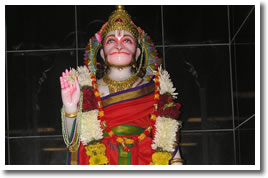 Sri Hanuman epitomizes the noble qualities of virtue, strength, knowledge, devotion, and worship of Lord Rama. Hindus worship the astoundingly righteous attributes represented by Hanuman that most humans find hard to practice, such as Brahmacharya (celibacy) and Bhakti (devotion). He is symbolized in Hinduism for his unwavering dedication to righteousness, unstinting performance of entrusted duties, and unfailing talents in serving his chosen master, Lord Rama. Believed to be an avatar of Lord Shiva, Hanuman is worshipped as a symbol of physical strength, perseverance, and devotion. Hanuman's tale in the epic Ramayana – where in he is assigned the responsibility to locate Rama's wife Sita abducted by Ravana, the demon king of Lanka – is known for its astounding ability to inspire and equip a reader with all the ingredients needed to face ordeals and conquer obstructions in the way of the world.
Sri Hanuman epitomizes the noble qualities of virtue, strength, knowledge, devotion, and worship of Lord Rama. Hindus worship the astoundingly righteous attributes represented by Hanuman that most humans find hard to practice, such as Brahmacharya (celibacy) and Bhakti (devotion). He is symbolized in Hinduism for his unwavering dedication to righteousness, unstinting performance of entrusted duties, and unfailing talents in serving his chosen master, Lord Rama. Believed to be an avatar of Lord Shiva, Hanuman is worshipped as a symbol of physical strength, perseverance, and devotion. Hanuman's tale in the epic Ramayana – where in he is assigned the responsibility to locate Rama's wife Sita abducted by Ravana, the demon king of Lanka – is known for its astounding ability to inspire and equip a reader with all the ingredients needed to face ordeals and conquer obstructions in the way of the world.
SRI SARASWATI
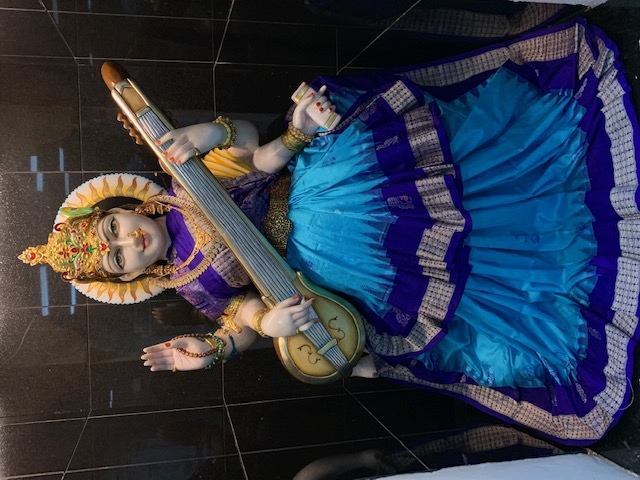 Saraswati, the goddess of knowledge and arts, represents the free flow of wisdom and consciousness. She is the mother of the Vedas, and chants directed to her, called the 'Saraswati Vandana' often begin and end Vedic lessons.
Saraswati is the daughter of Lord Shiva and Goddess Durga. It is believed that goddess Saraswati endows human beings with the powers of speech, wisdom and learning. She has four hands representing four aspects of human personality in learning: mind, intellect, alertness and ego.
In visual representations, she has sacred scriptures in one hand and a lotus--the symbol of true knowledge in the opposite hand.
Saraswati, the goddess of knowledge and arts, represents the free flow of wisdom and consciousness. She is the mother of the Vedas, and chants directed to her, called the 'Saraswati Vandana' often begin and end Vedic lessons.
Saraswati is the daughter of Lord Shiva and Goddess Durga. It is believed that goddess Saraswati endows human beings with the powers of speech, wisdom and learning. She has four hands representing four aspects of human personality in learning: mind, intellect, alertness and ego.
In visual representations, she has sacred scriptures in one hand and a lotus--the symbol of true knowledge in the opposite hand.
